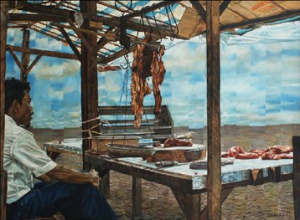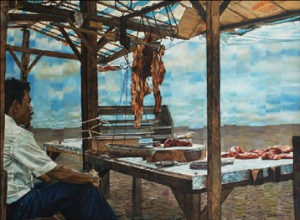[slideshow]
In our Fine Art Auction, 29 May 2011, we will be auctioning the collection of the late Mamannoor, Indonesian art critic and chronicler of Indonesian art. Here is what art critic Suwarno Wisetrotomo has to say about Mamannoor and his collection:
The Collection of the Late Mamannoor: A Chronicler of Indonesian Art
A genuine friend who was always ready to listen, always ready to document and record, a spirited explorer, who was assiduous in maintaining his friendships, are the words that perhaps best defines Mamannoor (born in Losari, West Java, August 21, 1958, died in Bandung, October 7, 2007), a writer, critic, curator, and diligent art documentor. He often refers to himself as an "inquisitor" of art. Indeed, it is a true confession: he diligently observed, listened, and recorded the visual arts in the entire country of Indonesia. It was his ambition to document and publish. The result is the increase in awareness about and the heightening of the esteem and dignity of the artists who would have otherwise remained unnoticed by art enthusiasts, collectors, and the media, up to the point that they have established a sense of self-confidence of being an artist.
Mamannoor explored small towns in Java, Sumatra, Kalimantan, Sulawesi, and so forth, and gathered data about the artists in the cities. He was close friends with the late art critic Sanento Yuliman, and who seemed to have motivated him to publish art books. Therefore, he relentlessly took and compiled notes. As a result, a number of books published monographs and critical studies, among others, about AD Pirous, Popo Iskandar, Amang Rahman, Jeihan, Huang Fong, Umi Dahlan, Taat Joeda, and Pupuk DP, and a number of writings scattered in various catalogs. Mamannoor also published Wacana Kritik Seni Rupa Indonesia, Sebuah Telaah Kritik Jurnalistik dan Pendekatan Kosmologis (The Discourse Surrounding Indonesia Art Criticism, An Interpretation Using Critical Journalism and a Cosmological Approach) published by Yayasan Nuansa Cendekia, Bandung, 2002, which was based on his master’s thesis during his graduate studies at The Art and Design Faculty of the Bandung Institute of Technology (1998). The Nusantara Art Exhibition which became permanent program of the National Gallery of Indonesia (GNI) was Mamannoor’s idea, when he became one of the curators of the National Gallery in 1998-2003.
The brief explanation about Mamannoor’s all-encompassing efforts above, can be used as the basis to comprehend the existence of works which forms his art collection. He was not an art collector, in the sense that he did not actively collect art works. If he had a collection, it was certainly because there was a correlation between his profession as an art observer, chronicler, critic, and curator. That is to say that the works in his collection can be called a "monument to friendships" with the artists. The friendships were really dear, special, and priceless, just like the works of the collection. The value of friendships with the artists were to be permanently commemorated through the art works displayed on the wall of his residence.
Mamannoor’s collection was very diverse: it included works of artists from Barli Sasmitawinata, Amrus Natalsya, Heyi Ma'mun, Asri Nugroho Nuspakurimba, Cadio Tarompo, Makhfoed, Awiki, Redha Sorana, S. Yadi, Xue Jiye (China), Antonius Kho, Acep Zamzam Noor, Toto Sunu, Putut Wahyu Widodo, to the generation of young artists like Rosid, Zirwen Hasri, or Hojatul Islam. The names were familiar in the Indonesian art stage; from established artists until those who are still growing. More than just a personal expression of the artists (with all their tendencies and messages), collectively or even one by one, the works in Mamannoor’s collection are really "monuments to friendships", the witness of the numerous trips that the late art critic made, as well as all the attention, sincerity, love, and perseverance he dedicated to the art world.
--Suwarno Wisetrotomo (Art curator, critic, and a good friend of Mamannoor)










